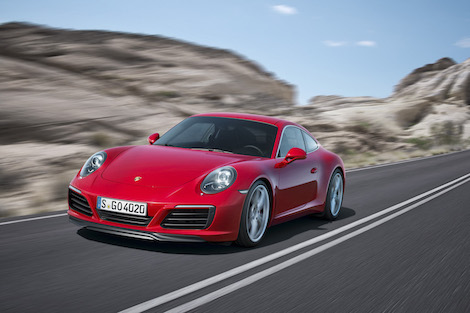Well, now all Porsche 911s are Porsche 911 turbos, albeit not Porsche 911 Turbos. The capital letter is significant, as while the all-conquering, all-powerful 911 Turbo remains one of the range-toppers for the globe's favourite flat-six sports car, the standard Carrera and Carrera S models now come with a new engine - out goes natural aspiration and in comes a 3.0-litre turbocharged flat-six, which brings more power and better economy.
The new engine has a 20hp power boost in both versions, so a standard Carrera's power curve climbs to a peak of 370hp, while the Carrera S now has 420hp. The Carrera breaks the 0-100km/h tape in just 4.2 seconds, while the Carrera S does so in 3.9 seconds (when it's fitted with Porsche's fast-shifting PDK semi-auto transmission). That makes it the first 'standard' 911 to break the 4.0 seconds barrier to 100km/h. Top speeds are 295km/h for the Carrera and 305km/h for the Carrera S.
Torque is up too, by 60Nm in both cases, bringing the total twist action to 450Nm for the Carrera and 500Nm for the Carrera S. Fuel economy though has improved, and that is the raison d'être of the switch to a more compact turbo engine. When fitted with the PDK 'box (which is more efficient than the manual) the Carrera scores a 7.4 litres per 100km combined fuel economy figure (that's an astonishing 38mpg) while the Carrera S claims 7.7 litres/100km (36mpg). In spite of the turbos, both engines rev to a maximum of 7,500rpm, so hopefully some of the old engine's metallic howl at high rpm has been retained. A 911 that doesn't sound like a 911 isn't a 911...
Inside there's a new touch-screen infotainment system with all the expected refinements (Apple CarPlay, Wi-Fi hotspot, armrest case that charges your phone and improves its reception) while there's a new navigation module that incorporates Google Maps and Google Street View.
More significantly, there's a new steering wheel. Yes, it's significant - not only is it based, style-wise, on the wheel from the 918 Spyder, it's also available in two sizes (standard; 375mm, Sports GT; 360mm) and it also has a new switch - the Ferrari-mannetino-like sports switch, again taken from the 918 Spyder. It allows you to switch between "Normal", "Sport", "Sport Plus" and "Individual" modes and there's also a "Sport Response Button" which, when pushed, tenses the car's systems for maximum acceleration for a few seconds. Think of it a push-to-pass button.
All cars now come as standard with Porsche's PASM electronically-controlled suspension, and all are 10mm lower than before, with a hydraulic lifter in the front suspension for dealing with awkward speed ramps or steep garage entrances. There are other refinements, such as a 'sailing' mode for the PDK gearbox which disengages the clutches when the car is rolling fast on the motorway to save fuel in tiny, second-long bursts, and an adaptive cruise control that can lightly ride the brakes on a long, downhill descent to keep your speed in check. There is also a pre-collision braking system and a blind spot monitor.
On the outside? Well, it's a 911 s don't go expecting radical changes. There are new lights (with the now characteristic Porsche four-point LED daytime running lights), new door handles and a new engine cover. It basically looks the same, but a bit sharper - just as you'd want it to. Check both models out in the video below.






